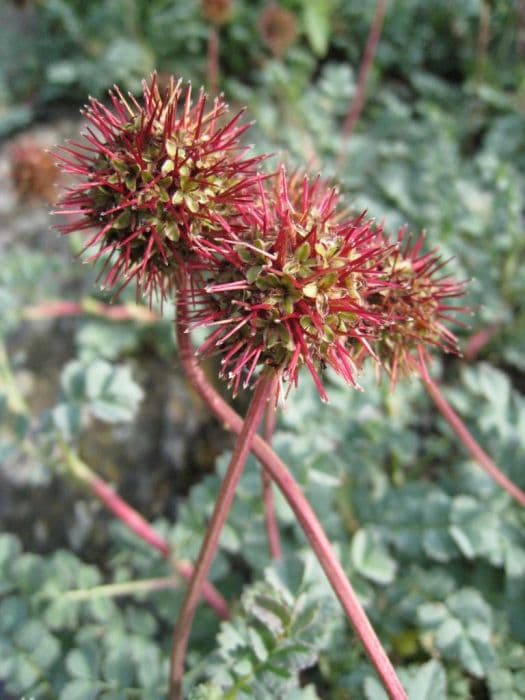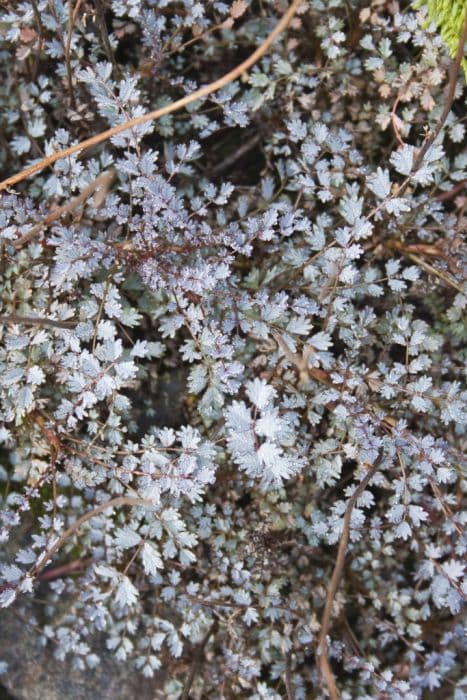Pershore Plum Prunus domestica 'Pershore' (C)

ABOUT
The Pershore plum, known specifically as the 'Pershore' cultivar of plum, showcases a pleasing aesthetic typical of plum trees. It bears a broad canopy that bursts into life with flowers in the spring. These blossoms are traditionally white, exuding a subtle fragrance and providing a contrast to the emerging green foliage. As the season progresses, the leaves fully develop into an oval shape with a pointed tip, possessing a smooth texture. The fruit of the Pershore plum is notable for its attractive yellow hue with a potential blush of red where the sun kisses the skin. The plums have a firm flesh that is both juicy and sweet, making them a favorite for fresh eating as well as culinary uses such as jams and jellies. The appearance of the fruit is generally rounded to oval, often with a slight indentation running along one side, which is a common characteristic among plum varieties.
About this plant
 Names
NamesSynonyms
Pershore Plum, Yellow Egg Plum, Pershore Yellow Egg, Pershore Golden Drop
Common names
Prunus domestica 'Pershore'
 Toxicity
ToxicityTo humans
The common name for Prunus domestica 'Pershore' is Yellow Egg Plum. Generally, the fruit is safe for human consumption when ripe. However, the seeds (also known as pits or stones) of the Yellow Egg Plum contain amygdalin, a compound that can release cyanide as it degrades in the digestive system. If a human ingests crushed or broken seeds in large quantities, they can experience symptoms of cyanide poisoning, which include headache, confusion, vomiting, difficulty breathing, and can be potentially life-threatening. It is important to avoid consuming the seeds, leaves, and stems of this plant.
To pets
Yellow Egg Plum, the common name for Prunus domestica 'Pershore', is potentially toxic to pets, such as dogs and cats. The toxicity primarily comes from the seeds or pits, leaves, and stems, which contain amygdalin that can metabolize into cyanide when ingested. This can cause symptoms like drooling, vomiting, difficulty breathing, seizures, and in severe cases, can be fatal. The fruit flesh itself is not considered toxic; however, ingestion of seeds or pits should be avoided to ensure pets' safety.
 Characteristics
CharacteristicsLife cycle
Perennials
Foliage type
Deciduous
Color of leaves
Green
Flower color
White
Height
12-15 feet (3.7-4.6 meters)
Spread
10-12 feet (3-3.7 meters)
Plant type
Tree
Hardiness zones
5
Native area
Europe
Benefits
 General Benefits
General Benefits- Nutritional Value: The fruit of the Pershore plum is rich in vitamins, minerals, and dietary fiber, contributing to a healthy diet.
- Culinary Uses: The plums can be used in a variety of culinary preparations, including jams, jellies, pies, and cakes, offering versatility in cooking and baking.
- Home Gardening: Gardening enthusiasts may enjoy growing the Pershore plum tree due to its attractive flowers and foliage, enhancing the aesthetic appeal of home gardens.
- Wildlife Attraction: The tree can attract pollinators like bees and birds, supporting local ecosystems and biodiversity.
- Economic Value: Cultivation of this plant may have economic benefits for growers and the agricultural sector by providing a source of income through selling the fruit.
- Shade Provider: Mature trees can offer shade in gardens and outdoor spaces, creating cooler areas during hot weather.
 Medical Properties
Medical PropertiesThis plant is not used for medical purposes.
 Air-purifying Qualities
Air-purifying QualitiesThis plant is not specifically known for air purifying qualities.
 Other Uses
Other Uses- The yellow plum can be used as a natural dye for fabric, yielding various shades of yellow, gold, or green depending on the mordant used.
- Wood from the yellow plum tree is valued for woodworking and can be used to make small decorative items, such as picture frames or jewelry boxes.
- Crushed kernels of the fruit have been traditionally used as a natural exfoliating scrub in homemade skincare recipes.
- The wood chips of the yellow plum tree are sometimes used in smoking foods to impart a fruity flavor.
- Leaves of the yellow plum can be used in compost as they break down quickly and add nutrients and organic matter to the soil.
- The dense foliage provides an excellent habitat for wildlife, offering shelter and food sources for birds and beneficial insects.
- Pruning clippings from the yellow plum tree can be used in decorative floral arrangements or as natural mulch in gardens.
- The fruit pits, when cracked open, contain a small seed that can be used to produce a fragrant oil commonly used in traditional soaps.
- Yellow plum trees can be planted as part of a permaculture orchard to work in harmony with other plants and create a self-sustaining ecosystem.
- In crafts, the smooth, oval stones of the fruit can be cleaned and used in creative projects, such as mosaics or as natural beads for jewelry making.
Interesting Facts
 Feng Shui
Feng ShuiThe European Plum is not used in Feng Shui practice.
 Zodiac Sign Compitability
Zodiac Sign CompitabilityThe European Plum is not used in astrology practice.
 Plant Symbolism
Plant Symbolism- Abundance - The Prunus domestica, commonly known as the plum tree, often bears a prolific quantity of fruit, symbolizing abundance and bounty.
- Renewal - As plum trees are one of the first plants to bloom in spring, they can represent new beginnings and the renewal of life.
- Innocence - The delicate blossoms of the plum tree have been associated with purity and the innocence of youth.
- Perseverance - Plum trees are known for their hardiness, able to withstand cold winters, symbolizing the idea of enduring through hardships.
- Wealth - In some cultures, plums are considered a symbol of wealth, both material and spiritual, due to their rich, sweet fruit.
 Water
WaterThe European Plum 'Pershore', commonly known as the Yellow Egg Plum, should be watered deeply once a week, providing 1 to 2 inches of water, which equates to about 0.62 to 1.25 gallons per square foot every seven days. During the growing season, if the climate is particularly dry or hot, you may need to water more frequently to maintain moist, but not waterlogged, soil. Young trees require regular watering to establish roots, whereas established trees might need less frequent water, but still enough to penetrate the root zone deeply. Always check the moisture level of the soil before watering to avoid overwatering, which can lead to root rot.
 Light
LightThe Yellow Egg Plum tree thrives best in full sunlight with at least six hours of direct, unfiltered sunlight per day. It prefers a spot that is open and sunny, away from shadows cast by buildings or taller trees. Ensuring it receives adequate light is crucial for the best growth, fruit production, and tree health.
 Temperature
TemperatureThe Yellow Egg Plum tree does well in a wide range of temperatures but can be damaged by late spring frosts after bud break. It can survive winter temperatures down to around -20°F, but the ideal growing temperatures are between 65°F and 75°F during the growing season. Extreme and prolonged heat above 95°F can stress the tree and affect fruit development.
 Pruning
PruningPruning the Yellow Egg Plum tree is necessary to maintain tree structure, remove diseased or damaged wood, and promote healthy fruit production. Pruning should be carried out in late winter or early spring before new growth begins, allowing the tree to heal quickly and minimize disease exposure. Thinning out branches can increase sunlight penetration and air circulation, which is beneficial for fruit ripening and reducing pest and disease pressure.
 Cleaning
CleaningAs needed
 Soil
SoilThe best soil mix for the Pershore Plum should be rich, well-draining with a pH of 5.5 to 6.5. A blend of loam, compost, and some sand will provide the ideal texture and fertility.
 Repotting
RepottingPershore Plums are typically grown outdoors and do not require repotting. If planted in containers, they should be repotted every 2-3 years to refresh the soil.
 Humidity & Misting
Humidity & MistingPershore Plums do well in average outdoor humidity levels; they do not demand any special humidity adjustments for optimal growth.
 Suitable locations
Suitable locationsIndoor
Growing Pershore Plums indoors isn't viable; they need outdoor conditions.
Outdoor
Plant in a sunny spot, provide ample water, and protect from strong winds.
Hardiness zone
5-9 USDA
 Life cycle
Life cycleThe Pershore Plum (Prunus domestica 'Pershore') begins its life as a dormant seed, which germinates in the spring when temperatures and moisture levels are favorable. It then develops into a seedling, where it establishes roots and shoots that grow into a young sapling. As it matures, the sapling develops into a flowering tree, typically within a few years, with the flowers being pollinated by insects to produce fruit. Following pollination and fertilization, the tree bears plums by mid to late summer, which ripen and can be harvested. Once the fruit is harvested, the tree enters a period of dormancy during the winter months. The Pershore Plum completes this cycle annually, with the tree having the potential to live and produce fruit for several decades.
 Propogation
PropogationPropogation time
Summer
The most popular method of propagating Prunus domestica 'Pershore', commonly known as the Pershore Plum, is by grafting. This technique involves taking a piece of stem from a mature Pershore Plum with desirable characteristics, called a scion, and joining it onto the root system of a compatible rootstock, which provides the necessary support and nutrients for the new plant. Grafting is usually done during the late winter or early spring when the tree is dormant and before the sap starts to flow. The scion is carefully cut at an angle to expose a fresh surface and then placed onto a similarly cut surface on the rootstock. The two pieces are bound tightly together, often with grafting tape or wax, to encourage the tissues to fuse as the plant heals and begins to grow. This method ensures that the new tree will bear fruit that is identical to that of the parent tree from which the scion was taken.









